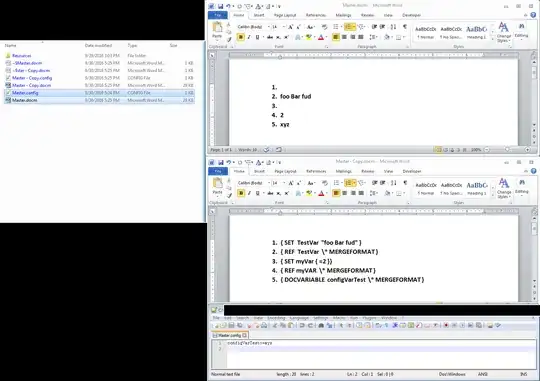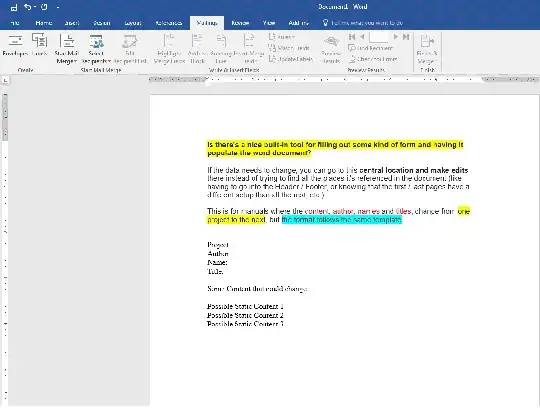Not my cleanest code, but it gets the job done.
SOLUTION
This will load a series of key-value pairs from a text file into the Word Document's ActiveDocument.Variables list. These Variales are stored persistently in the Document, but I chose to break them out to avoid duplication and orphaning of variables (see sledge hammer deletion in code).
The variable values can then be displayed using Fields throughout the Document by referencing the DOCVARIABLEs by name.
Code below has no error handling, but does some basic parsing checks to avoid crashing. Not tested very extensively though, so do your own due diligence.
USAGE:
Place code in the Document On Open Event handler. It will create a file with the same name as the Word Document, but with a ".config" extension.
On creation. the config file will have all current ActiveDocument.Variables written to it to ensure you don't open a blank file accidentally if you copy the Doc and forget or don't know about the .config file.
If the config file exists, then all doc variables are deleted from memory and the ones in the config are loaded into memory. You can change the value of a variable in the config file and it will be updated throughout the document the next time you open it.

Option Explicit
Private Sub Document_Open()
'Dim
Dim i As Long
Dim Folder As String
Dim FileName As String
Dim FullPath As String
Dim FileText As String
Dim Item As Variant
Dim Table As Scripting.Dictionary
Dim Key As Variant
' Open or Create Config File
With New FileSystemObject
' Setup Path
Folder = ThisDocument.Path & "\"
FileName = .GetBaseName(ThisDocument.Name)
FullPath = Folder & FileName & ".config"
If (.FileExists(FullPath)) Then
' Sledge Hammer Cleanup of Document Vars, avoids memory bloat by synchronizing variables with .config file
For i = ActiveDocument.Variables.Count() To 1 Step -1
ActiveDocument.Variables.Item(i).Delete
Next i
' Open / Read
With .OpenTextFile(FullPath, ForReading, False)
' Get File Contents
If Not (.AtEndOfStream) Then
FileText = .ReadAll
End If
.Close
End With
Else
' Create / Write
With .OpenTextFile(FullPath, ForWriting, True)
' Write One Key-Value pair per line
For Each Item In ActiveDocument.Variables
.WriteLine (Item.Name & ":=" & Item.Value)
Next
.Close
End With
End If
End With
' Parse Config Text for Runtime
Set Table = ParseVariables(FileText)
For Each Key In Table.Keys
ActiveDocument.Variables(Key) = Table(Key)
Next
' Update All Fields in Document
ActiveDocument.Fields.Update
' Save File so user does not get nuisance prompts
ActiveDocument.Save
End Sub
Private Function ParseVariables(text As String) As Scripting.Dictionary
' Dim
Dim i, n As Long
Dim Lines As Variant: Lines = Split(text, vbCrLf)
Dim VarTable As New Scripting.Dictionary
Dim Key, Value As String
' Loop
For i = LBound(Lines) To UBound(Lines)
Debug.Print ("Lines(" & i & ") = " & Lines(i))
' Find the ":=" delimiter in each line that splits the variable name from its value
n = InStr(1, Lines(i), ":=", vbBinaryCompare)
' Escape if not delimited
If (n > 0) Then
' Extract Key before ":=" and Value from after ":="
Value = Mid(Lines(i), n + 2)
Key = Trim(Mid(Lines(i), 1, Len(Lines(i)) - Len(Value) - 2))
' Escape if either Key or Value are empty
If (Len(Key) > 0) And (Len(Value) > 0) Then
VarTable.Item(Key) = Value
End If
End If
Next i
' Return
Set ParseVariables = VarTable
End Function

